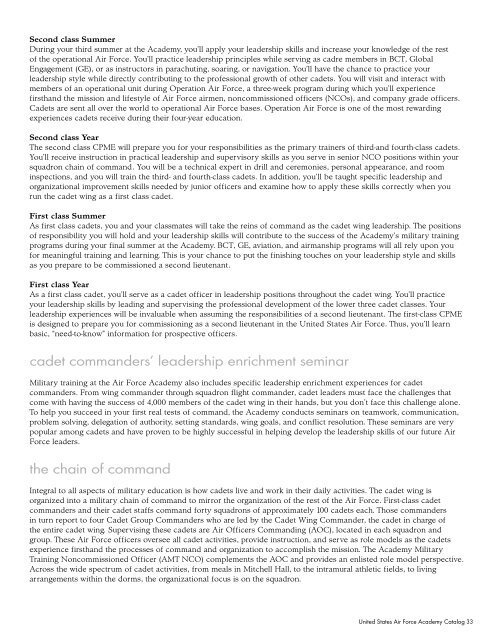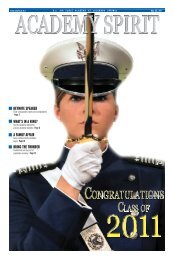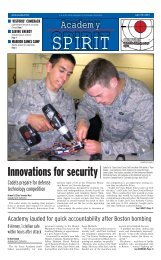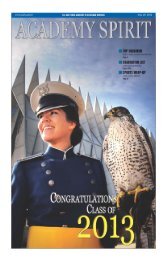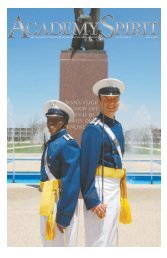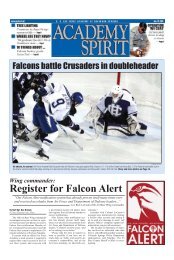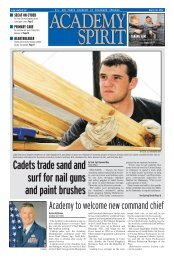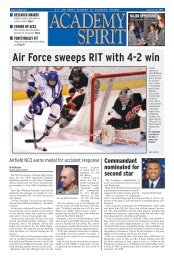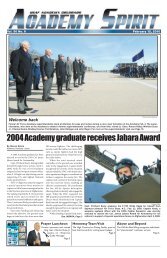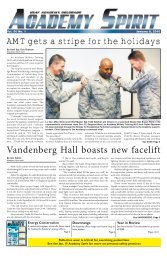2008-2009 Catalog - United States Air Force Academy
2008-2009 Catalog - United States Air Force Academy
2008-2009 Catalog - United States Air Force Academy
You also want an ePaper? Increase the reach of your titles
YUMPU automatically turns print PDFs into web optimized ePapers that Google loves.
Second class Summer<br />
During your third summer at the <strong>Academy</strong>, you’ll apply your leadership skills and increase your knowledge of the rest<br />
of the operational <strong>Air</strong> <strong>Force</strong>. You’ll practice leadership principles while serving as cadre members in BCT, Global<br />
Engagement (GE), or as instructors in parachuting, soaring, or navigation. You’ll have the chance to practice your<br />
leadership style while directly contributing to the professional growth of other cadets. You will visit and interact with<br />
members of an operational unit during Operation <strong>Air</strong> <strong>Force</strong>, a three-week program during which you’ll experience<br />
firsthand the mission and lifestyle of <strong>Air</strong> <strong>Force</strong> airmen, noncommissioned officers (NCOs), and company grade officers.<br />
Cadets are sent all over the world to operational <strong>Air</strong> <strong>Force</strong> bases. Operation <strong>Air</strong> <strong>Force</strong> is one of the most rewarding<br />
experiences cadets receive during their four-year education.<br />
Second class Year<br />
The second class CPME will prepare you for your responsibilities as the primary trainers of third-and fourth-class cadets.<br />
You’ll receive instruction in practical leadership and supervisory skills as you serve in senior NCO positions within your<br />
squadron chain of command. You will be a technical expert in drill and ceremonies, personal appearance, and room<br />
inspections, and you will train the third- and fourth-class cadets. In addition, you’ll be taught specific leadership and<br />
organizational improvement skills needed by junior officers and examine how to apply these skills correctly when you<br />
run the cadet wing as a first class cadet.<br />
First class Summer<br />
As first class cadets, you and your classmates will take the reins of command as the cadet wing leadership. The positions<br />
of responsibility you will hold and your leadership skills will contribute to the success of the <strong>Academy</strong>’s military training<br />
programs during your final summer at the <strong>Academy</strong>. BCT, GE, aviation, and airmanship programs will all rely upon you<br />
for meaningful training and learning. This is your chance to put the finishing touches on your leadership style and skills<br />
as you prepare to be commissioned a second lieutenant.<br />
First class Year<br />
As a first class cadet, you’ll serve as a cadet officer in leadership positions throughout the cadet wing. You’ll practice<br />
your leadership skills by leading and supervising the professional development of the lower three cadet classes. Your<br />
leadership experiences will be invaluable when assuming the responsibilities of a second lieutenant. The first-class CPME<br />
is designed to prepare you for commissioning as a second lieutenant in the <strong>United</strong> <strong>States</strong> <strong>Air</strong> <strong>Force</strong>. Thus, you’ll learn<br />
basic, “need-to-know” information for prospective officers.<br />
cadet commanders’ leadership enrichment seminar<br />
Military training at the <strong>Air</strong> <strong>Force</strong> <strong>Academy</strong> also includes specific leadership enrichment experiences for cadet<br />
commanders. From wing commander through squadron flight commander, cadet leaders must face the challenges that<br />
come with having the success of 4,000 members of the cadet wing in their hands, but you don’t face this challenge alone.<br />
To help you succeed in your first real tests of command, the <strong>Academy</strong> conducts seminars on teamwork, communication,<br />
problem solving, delegation of authority, setting standards, wing goals, and conflict resolution. These seminars are very<br />
popular among cadets and have proven to be highly successful in helping develop the leadership skills of our future <strong>Air</strong><br />
<strong>Force</strong> leaders.<br />
the chain of command<br />
Integral to all aspects of military education is how cadets live and work in their daily activities. The cadet wing is<br />
organized into a military chain of command to mirror the organization of the rest of the <strong>Air</strong> <strong>Force</strong>. First-class cadet<br />
commanders and their cadet staffs command forty squadrons of approximately 100 cadets each. Those commanders<br />
in turn report to four Cadet Group Commanders who are led by the Cadet Wing Commander, the cadet in charge of<br />
the entire cadet wing. Supervising these cadets are <strong>Air</strong> Officers Commanding (AOC), located in each squadron and<br />
group. These <strong>Air</strong> <strong>Force</strong> officers oversee all cadet activities, provide instruction, and serve as role models as the cadets<br />
experience firsthand the processes of command and organization to accomplish the mission. The <strong>Academy</strong> Military<br />
Training Noncommissioned Officer (AMT NCO) complements the AOC and provides an enlisted role model perspective.<br />
Across the wide spectrum of cadet activities, from meals in Mitchell Hall, to the intramural athletic fields, to living<br />
arrangements within the dorms, the organizational focus is on the squadron.<br />
<strong>United</strong> <strong>States</strong> <strong>Air</strong> <strong>Force</strong> <strong>Academy</strong> <strong>Catalog</strong> 33


